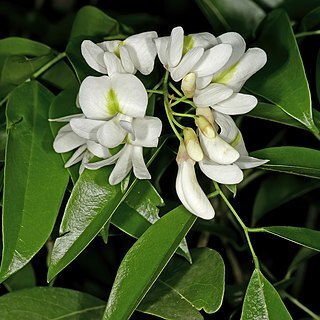Large or small tree; young twigs, leaf-rhachis, petiolules and underside of leaflet-midribs almost glabrous or sparsely brown pilose with hairs ± 1 mm. long, later glabrescent.. Stipules very caducous; leaf-rhachis up to 9 cm. long; leaflets 3–5, ovate or lanceolate, acuminate, up to 10 by 5 cm.; principal nerves 5–6 on each side.. Raceme 5–10-flowered, shorter than subtending leaf, the rhachis sparsely brown pilose with long hairs; bracts very caducous; pedicels glabrous or nearly so, up to 13 mm. long; bracteoles caducous, linear or spathulate, under 0.5 mm. wide near the base, 2–3 mm. long, pubescent above the middle.. Calyx glabrous or nearly so; tube 3–4 mm.; lobes 0.5–1.5 mm. long.. Corolla 15–17 mm. long.. Filament-sheath 10 mm., free parts 4–6 mm., anthers 0.7 mm. long.. Ovary with a few hairs on the sutures only, 2–5-ovulate; style ± 7 mm. long.. Pod 6–11 cm. long, 2–3.5 cm. wide, 2–3-seeded.. Seed up to 27 × 18 × 8 mm.
Small, evergreen tree, up to 5 m high. Leaves glossy green, leathery, with rachis up to 90 mm long; petioles with swelling near base. Leaflets 3-5, alternate to subopposite, up to 100 mm long, ovate to lanceolate. Stipules caducous. Inflorescences 5-10-flowered racemes, shorter than subtending leaf; pedicels up to 13 mm long. Flowers white becoming pink with age, sweetly scented. Calyx glabrous; tube 3-4 mm long. Petals 15-17 mm long. Flowering time Sept.-Nov. Pod 60-110 mm long, 2-or 3-seeded.
Leaves 3–5(6)-foliolate; petiole 2.5 cm long; rachis up to 6.5 cm long; leaflets ± subcoriaceous, 3–10 × 1.5–5 cm, ovate, elliptic, elliptic-lanceolate or sometimes round, acuminate at the apex, broadly cuneate to truncate at the base; lateral nerves 5–6 on each side; stipules falling very early; petiolules 3 mm long.
Inflorescences scented, 15–20 cm long, 5–10-flowered, the rachis with rather long chestnut-brown hairs; bracts very deciduous; bracteoles 2–3 mm long, under 0.5 mm wide at base, linear to spathulate, deciduous; pedicels 10 mm long.
Corolla white; standard 1.3 × 1.1 cm, with claw 1.5 mm long; wing blades 12 × 4.5 mm, oblong, with claw 4 mm long; blades of keel petals 11.5 × 5 mm, with claw 4.5 mm long.
Seeds ± blackish, 1.6–2.3(2.7) × 1.2(1.8) × 0.4–0.9 cm, oblong-ellipsoid, subrhomboid or compressed, obscurely striate and pitted.
Young twigs, leaf rachides, petiolules and leaflet midribs sparsely rusty pubescent with hairs c.1 mm long, or almost glabrous.
Shrub or small to medium-sized tree 2–15 m tall, with white or pale grey scaly or slightly flaking bark.
Filament sheath 10 mm long, with free parts of filaments 4–6 mm long; anthers 0.7 mm long.
Ovary glabrous or with few hairs on the sutures, 2–5-ovuled; style c.7 mm long.
Calyx reddish, glabrous or nearly so; tube 3–4 mm long; lobes 0.5–1.5 mm long.
Pods 5–9(11) × 1.7–3.5 cm, lanceolate or elliptic-oblong, venose when young.


